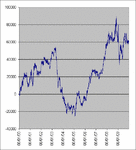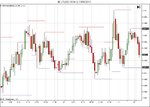Adamus
Experienced member
- Messages
- 1,898
- Likes
- 97
Shock horror
I logged on to IB thinking I had £33.6K in the account. I pulled up the account page and it said £32.2K. After I regained control of my eyebrows I then decided it must be because I'd radically miscalculated the loss on a EUR/JPY trade last week.
I then spent the rest of the evening in a foul mood and managed to start a row with my girlfriend and started hatching a conspiracy theory about a clerk at IB skimming off money from customer accounts.
I logged in just now and the markets are back up (IB has them shut down until 5pm NY time) and my account is back to £33.6K.
I'm really not totally sure what's going on there but either the positions I had on over Saturday are a lot more volatile than I thought or I don't actually understand how IB handles forex trading balances.
I logged on to IB thinking I had £33.6K in the account. I pulled up the account page and it said £32.2K. After I regained control of my eyebrows I then decided it must be because I'd radically miscalculated the loss on a EUR/JPY trade last week.
I then spent the rest of the evening in a foul mood and managed to start a row with my girlfriend and started hatching a conspiracy theory about a clerk at IB skimming off money from customer accounts.
I logged in just now and the markets are back up (IB has them shut down until 5pm NY time) and my account is back to £33.6K.
I'm really not totally sure what's going on there but either the positions I had on over Saturday are a lot more volatile than I thought or I don't actually understand how IB handles forex trading balances.




